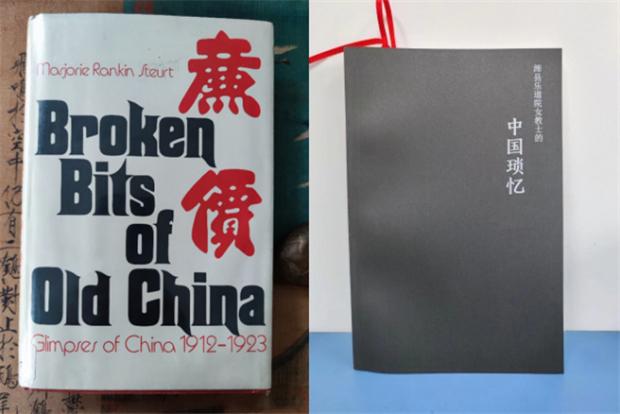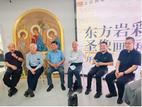Written by a Presbyterian missionary and an American teacher Marjorie Rankin Steurt, and voluntarily translated by Mr. Sun Min locally from Weifang, Shandong Province, the Chinese draft version of her book Broken Bits of Old China was completed on December 12th, 2020. The book’s Chinese title is The Collected Memories of China from a Female Missionary of the Weihsien Courtyard of the Happy Way. The translated work has been donated to Weifang Library and other public libraries such as Kuiwen, Fangzi, Anqiu, and Linqu.
Although the translator Sun is not a Christian, in his view, the local literature value of this book is worthy of attention.
As a native of Weifang, Sun Min, the translator, would like to eventually help people who need to know Weifang better through efforts of mining, collecting, and filing the local historical documents of Weifang.
Recently, Christian Times, a Chinese Christian newspaper, interviewed Sun Min virtually, who shared his experience and reflection of translating the book.
Christian Times: What kind of book do you think Broken Bits of Old China (hereinafter referred to as Broken Bits) is?
Sun Min: First of all, Broken Bits is a memoir. It is not large in word number with a total of 26 sections. It was translated into about 70,000 Chinese characters. The original English version was published in 1973 presenting recordings of events from 1912 to 1917. According to the introduction by the publisher Thomas Nelson Publishing Company, the book was based on letters from Marjorie to her father.
Marjorie Rankin Steurt was initially an educator and she had an academic background in the education sector. Born in Pennsylvania in 1888, she first obtained a bachelor’s degree from Mount Holyoke College, and successfully obtained a master’s and a doctor’s degree from Columbia University. In 1912, she was appointed to China by the North American Presbyterian Church. She once worked as a teacher and the principal of Wen Mei School for Girls which was affiliated with Wei County (Weihsien) Le Dao Yuan. From 1926 to 1927, she taught in the English Department of Cheeloo University. In 1929, at the invitation of Zhang Boling (a famous Chinese educator, translator’s note), she came to China again from the United States to serve as an experiment instructor at Nankai Primary School. Three years later she resigned and returned to the United States.
In the book, Marjorie recorded the first five years (1912-1917) of life that she experienced as a church teacher when she worked in Weixian County (Weihsien), Shandong Province. She chose what she thought was the best part.
Regarding her experience in Weixian County, she said: “Though (I) was assigned to China by the Presbyterian Church, I never claimed to be a missionary. I would rather recognize myself as a teacher who had experienced unusual adventures in China.” According to the translator himself, her book was first published for American readers. “I hope that through these brief and fragment recordings, readers can get a general idea of the deep-rooted traditional civilization of ancient China, and then help Americans know more about modern China.”
All her recordings were the daily scenes of the ordinary, “their weddings and funerals, their approvals and prejudices, their face-saving approaches, their poverty and daily life, all these life fragments sad or hilarious were presented with a little humor from the perspective of this sympathetic western observer.”
Christian Times: What was your original intention in translating this book?
Sun Min: As a volunteer who mines and collates local documents, the original intention of translating this book was the same as that of collating other local documents - I call it the “origin” issue.
I want to know something about what kind of people there were in this land where I was born, grew up, or lived temporarily. What happened? The time is the past, the place is here, they are the people, and the events are history.
In this process, I encountered this book by Marjorie Rankin Steurt. The records made by westerners from the first person’s view are highly authentic and interesting, from which we can truly understand the social features of China in centuries gone by, especially in Wei County.
Christian Times: What kind of learning and inspiration do you hope Broken Bits will bring to today’s readers?
Sun Min: In addition to knowing some historical truth through this book, I hope readers can gain a view of the history of “respect” and “sympathy”. “Sympathy” here does not mean taking pity, but the ability to have a kind of “empathy”.
In Marjorie Rankin Steurt’s records, her writing was objective, maintaining an objective “respect” and “sympathy”. Although she also described some backwardness as well as bad customs in the book, she did not show contempt or disdain but presented her understanding of the plight that others had with a sense of empathy.
It is this kind of respect and empathy that Broken Bits presents under a variety of differences. Marjorie Rankin Steurt, from America, observed Wei County and even China from her perspective. It is a kind of spatial difference. Our current readers are from the 20s of the 21st century, looking back at Wei County and China in the early 20th century. It is a difference in time period. Will readers in the latter dimension of time be able to maintain a kind of respect and empathy like Marjorie Rankin Steurt did in the earlier and thus vastly different dimension of space?
Christian Times: What are the concrete manifestations of what were the greatest difficulties in the lives of missionaries in Weifang at that time?
Sun Min: The foreigners serving Wei County Le Dao Yuan mainly had language, living conditions and lifestyle problems, differences in medical conditions, and conflicts with local people.
Christian Times: In the process of translation, what do you think of the historical contribution and value left initially by the missionaries through their service in Le Dao Yuan? How do you think we view these contributions today?
Sun Min: The book does not cover the macro picture of construction and development, but depicts some small details, such as education or medical care and so on. However, according to my understanding of the history of Weihsien Le Dao Yuan, the final development pattern of Le Dao Yuan was the trinity of church, school, and hospital. For the social development process, although the functions of education and medical care were around missionary work, it objectively promoted the development process of regional modern education and medical care.
For missionaries, we should still understand and evaluate them from an objective standpoint. Like Marjorie Rankin Steurt, we should also understand the efforts of foreign missionaries for religious dissemination and their objective contributions to the promotion of social civilization in a place with a view of respect and empathy.
- Translated by Charlie Li












